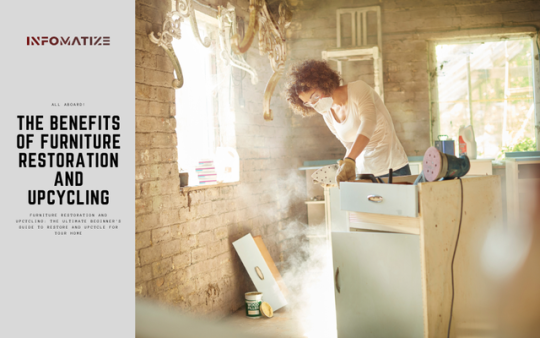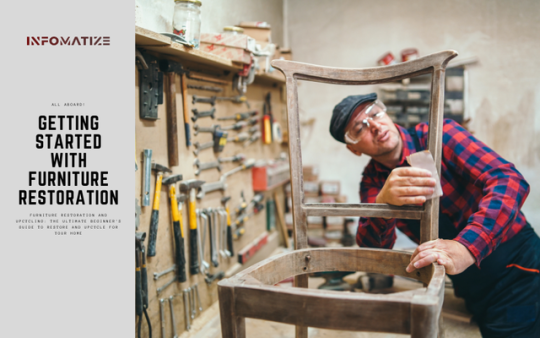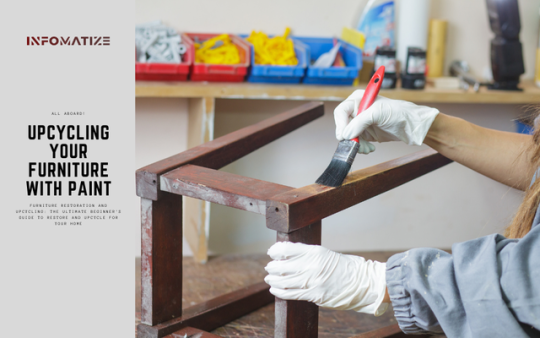#DIYfurniturerestoration
Explore tagged Tumblr posts
Text
Furniture Restoration and Upcycling: The Ultimate Beginner's Guide to Restore and Upcycle for Your Home

Introduction:
If you're looking for a way to bring new life to your old furniture while also promoting sustainability, furniture restoration and upcycling are excellent options. In this comprehensive guide for beginners, we'll walk you through the steps to restore and upcycle your furniture to create a fresh look while doing your part for the environment. Firstly, cleaning your furniture is an essential first step before beginning any restoration or upcycling work. This can involve using gentle cleaners or soap and water to remove dirt, dust, and grime that may have accumulated over time. Once cleaned, you can then assess the furniture's condition and determine what needs to be repaired, replaced, or restored. If you're looking to restore damaged or worn-out furniture, it may be necessary to replace hardware such as drawer pulls, knobs, or handles. You can also consider repairing any structural damage by filling in cracks, smoothing out scratches, and sanding rough edges. Additionally, consider re-staining or painting your furniture to give it a fresh look . Upcycling your furniture is another option to consider. This involves taking your old furniture and transforming it into something new and unique. Some popular upcycling ideas include turning old chairs into planters, transforming dressers into bathroom vanities, or repurposing old headboards into benches . The possibilities are endless, and you can get as creative as you want. Regardless of whether you decide to restore or upcycle your furniture, it's important to keep sustainability in mind. Upcycling old furniture not only reduces waste but also promotes sustainable living. You can also consider using eco-friendly paints and materials when restoring your furniture to reduce your carbon footprint . Overall, furniture restoration and upcycling are fantastic ways to breathe new life into old furniture while promoting sustainability. With the right tools and techniques, you can transform your old furniture into something unique and beautiful, all while doing your part for the environment.
The Benefits of Furniture Restoration and Upcycling

Furniture restoration and upcycling offer several benefits for both the environment and individuals. One of the most significant advantages is reducing waste and saving resources by keeping items out of landfills. Upcycling also contributes to the fight against deforestation and plastic production, which are responsible for soil erosion, biodiversity loss, greenhouse gas emissions, and pollution . Furniture restoration and upcycling also have mental benefits, as they can boost creativity, foster a sense of community, and teach valuable home repair skills . Furthermore, upcycling can create unique and personalized items of higher quality or value than the original . Restoring old furniture also has environmental benefits as it requires less energy and produces fewer carbon dioxide emissions than making new furniture from scratch. Moreover, restoring old furniture preserves heritage designs while reducing the need for new materials and resources . In summary, furniture restoration and upcycling offer several benefits such as reducing waste, saving resources, fighting against deforestation and plastic production, boosting creativity, building community, and preserving heritage designs. Moreover, restoring old furniture has environmental benefits such as producing fewer carbon dioxide emissions and preserving resources. Why Furniture Restoration and Upcycling is Good for the Environment Furniture restoration and upcycling offer many benefits to the environment. Firstly, buying or repurposing used furniture instead of purchasing new ones reduces waste, as Americans discard over 12 million tons of furniture each year, with 80% of it ending up in landfills . Secondly, it helps prevent deforestation, which contributes to biodiversity loss, soil erosion, and 15% of global greenhouse gas emissions, as buying new items made from wood means cutting down trees . Upcycling furniture is also financially sensible, as converting a rejected object into something useful increases its value . Additionally, upcycling reduces waste and the need to use unethically sourced or unsustainable materials, like plastic, to create new products, benefiting the planet . Moreover, upcycling encourages creativity and can become a fun hobby for some people, and it has a fairly large online community on platforms like Pinterest and Facebook . Furniture restoration, on the other hand, is all about returning a piece of furniture to its original condition, involving repairing any damage, refinishing the wood, and replacing any missing parts . Restoration reduces the need to dispose of classic furniture, lowering the amount of waste added to overflowing landfills and the negative environmental impact of harmful chemicals emitted from the rubbish . Additionally, furniture refinishing helps make damaged and worn-out pieces pristine again, regaining their value, and can also be used as a way to reduce waste . In summary, furniture restoration and upcycling have numerous benefits to the environment, including reducing waste, preventing deforestation, reducing the need for unethically sourced or unsustainable materials, encouraging creativity and a fun hobby, and regaining the value of antique furniture. How Upcycling Can Save You Money Upcycling is the process of taking an object that is considered to no longer be useful and repurposing it into something new and functional. Upcycling can save you money in various ways. Firstly, upcycling allows you to use what you already have and save money on buying new products. By repurposing old items, you can create new and beautiful items without spending much money . Secondly, upcycling can help you save costs as you can turn something that you were going to throw away into something useful again . Thirdly, upcycling can reduce your consumption of new raw materials when creating new products, thus reducing energy usage, air and water pollution, and even greenhouse gas emissions. By reusing materials, you are also reducing the amount of waste that ends up in landfills . Finally, upcycling can also become an alternative to a personal or small business loan or even a means of earning extra cash by reducing expenses . Overall, upcycling is an excellent way to save money and reduce waste while getting creative and innovative in repurposing old items. The Unique Benefits of Restoring Old Furniture Restoring old furniture comes with a number of benefits that can make the effort and expense worthwhile. Here are some unique benefits of restoring old furniture that is supported by various Sources: - Increased value: By restoring old furniture, you can bring it back to its original condition, which can increase its value. According to one source, "Antique furniture restoration can increase the value of your piece, sometimes significantly" . - Environmental benefits: Restoring old furniture can be more environmentally friendly than buying new furniture. Furniture-making is energy-intensive and produces a significant amount of carbon dioxide emissions. By restoring old furniture, you can help reduce the demand for new furniture and prevent deforestation . - Unique styles and craftsmanship: Old furniture often features unique styles and craftsmanship that may not be available in modern furniture. By restoring old furniture, you can preserve these unique features and enjoy them in your home . - Less wasteful: Americans discard more than 12 million tons of furniture each year, with 80% of it ending up in landfills. By restoring old furniture, you can help reduce this waste and extend the lifespan of furniture pieces . - Personal satisfaction: Restoring old furniture can be a fulfilling and rewarding experience. It allows you to give new life to old pieces and create something unique that reflects your personal style . In conclusion, restoring old furniture can offer a variety of benefits, including increased value, environmental benefits, unique styles and craftsmanship, less waste, and personal satisfaction. If you are interested in restoring old furniture, be sure to research appropriate techniques and materials to ensure that your project is successful.
Getting Started with Furniture Restoration

Furniture restoration can be a rewarding and eco-friendly hobby or business. If you are interested in getting started with furniture restoration, here are some tips: - Learn the basics of furniture restoration: Before spending any money, familiarize yourself with local ordinances and laws concerning toxic chemicals such as lead in older paints and flame retardants in modern furniture. - Evaluate your furniture: Before starting any restoration work, evaluate your furniture and determine what needs to be done. Use mineral spirits to clean and evaluate the condition of the wood. - Clean your furniture: Before refinishing your furniture, clean it thoroughly with dish soap and warm water. If necessary, use mineral spirits or toothpaste and steel wool to remove grime and buildup. - Remove the old finish: You'll have to remove the old finish before you can apply a new one. Strip the wood with a power sander (an orbital sander, random orbital sander, or belt sander work well) and fine-grit sandpaper. - Re-glue any loose joints: Use a mallet to gently re-break any joints or cracks, so you can get to the surfaces where glue will be applied. Excavate any globs of glue from previous repairs. - Refinish your furniture: Apply a new finish to your furniture using a brush, spray gun or rag. You can use wax, gel stain, or filler sticks for wood to create a smooth and polished finish. Remember to ensure that you're using eco-friendly restoration practices, especially when buying old wood furniture that you can easily turn into something new or refurbish. If you plan to upcycle chairs and footstools, you'll need to learn how to reupholster furniture. Starting a furniture restoration business requires a little start-up investment and is a great way to work from home. Choosing the Right Tools and Materials When it comes to building or designing, choosing the right tools and materials is crucial. There are a plethora of decisions that need to be made by builders, architects, homeowners, and anyone else who works on houses. Some decisions are personal preferences, while others can make or break the project. Here are some tips and considerations to keep in mind when choosing the right tools and materials: - Quality vs. Cost: When it comes to choosing tools, finding a balance between quality and cost is essential. Higher-quality tools may be more expensive but can last longer and make your life easier . On the other hand, lower-quality tools may be more affordable but may not last as long. - Material Selection: Selecting the right materials for your project is equally important. Consider what you are building, the problem it solves, your target user(s), the other products in the market that aim to solve the same problem, and the availability and pricing of materials . - Types of Tools: There are two main types of tools: hand tools and power tools . Hand tools are the most basic and include everything from hammers and screwdrivers to wrenches and pliers. Power tools, on the other hand, are designed to make your life easier by providing a mechanical advantage. Common power tools include drills, saws, and sanders. - Material Properties: The properties of the materials being worked with are also crucial to consider. For example, when cutting metal, the choice of cutting tool depends on whether the metal is ferrous or non-ferrous, which determines its hardness, strength, ductility, thermal conductivity, and chemical composition . - Quality of Tools: The quality of the manufacturing materials of the blade, handle, and fittings should be considered when choosing hand tools . Choosing the right tools and materials is crucial to the success of any building or design project. By keeping these tips and considerations in mind, builders, architects, and homeowners can make informed decisions that will lead to successful projects. Preparing Your Furniture for Restoration Restoring furniture can be a fun and rewarding DIY project that breathes new life into old pieces. Before you begin the restoration process, it's important to properly prepare your furniture for the task at hand. Here are some tips on how to prepare your furniture for restoration based on various Sources: - Clean the furniture: Before beginning the restoration process, it's important to clean the furniture thoroughly to remove any dirt, grime, or debris that may have accumulated over time. To do this, you can use mild dish soap, warm water, and a sponge . Alternatively, you can use a mixture of vinegar and olive oil to restore shine to your furniture . - Remove the old finish: In order to apply a new finish to your furniture, you'll need to remove the old finish first. You can do this using a power sander (such as an orbital sander, random orbital sander, or belt sander) and fine-grit sandpaper . You can also use mineral spirits to remove the old finish by soaking a cloth and wiping down the furniture in a well-ventilated area . - Protect the blade of your scraper: When removing paint or other materials from your furniture, it's important to use a scraper with a protected blade. To do this, wrap a layer of masking tape around each end of the blade and bend the blade slightly so it's curved. This will hold the blade slightly off the surface so you can knock off paint spatters without the blade even touching the wood . - Give the furniture a good sanding: Once you've removed the old finish, you'll need to sand the furniture to prepare it for the new finish. Begin with coarse-grit sandpaper to remove any remaining finish, and then work your way up to fine-grit sandpaper to smooth out the surface of the wood . - Apply a new finish: Finally, you can apply a new finish to your furniture. To do this, use a brush or lint-free cloth to apply a coat of finishing oil to the wood. Allow the oil to penetrate for 10 minutes and then wipe away any excess before it becomes sticky . By following these steps, you can properly prepare your furniture for restoration and ensure that your finished product looks beautiful and lasts for years to come. Repairing and Sanding Your Furniture Repairing and sanding your furniture can be a great way to restore its beauty and functionality. Here are some tips based on the various sources to help you get started. Before sanding your furniture, make sure to remove any excess dust or dirt from the repair area using a clean rag . You should also check for any deep gouges, cracks, or dents and fill those with wood filler to get the best finish possible . Once the surface is clean and smooth, you can begin sanding. To sand your furniture, you can use sandpaper with different grits depending on the job. Medium grit (80-150) is great for general sanding and removing old paint or stain, while fine grit (180-220) is ideal for scuffing up furniture before painting and smoothing out a wood's finish. Extra fine grit (320-400) is used for the final sanding before finishing the wood . When sanding, be sure not to scratch the area surrounding the damage . If you're dealing with scratches or surface damage, you can try using scratch remover that matches the wood's colour. Apply a small amount of the scratch remover onto a cloth and buff it over the damaged area . Another option is to use rottenstone mixed with oil to make a thin paste, which can be gently rubbed over the stain along the grain of the wood. Rottenstone is a fast-cutting abrasive, so be sure to rub very carefully and check the surface frequently to avoid cutting too deep . If your furniture has joint or structural damage, you may want to consider professional repair services. Furniture Medic, for example, offers in-home or on-site furniture repair as a convenient alternative to costly furniture replacement . When restoring furniture, it's important to focus on restoration rather than revamping, especially with valuable pieces. Do some research and use your best judgment, and seek the advice of a professional if necessary to ensure the furniture maintains its value . Overall, repairing and sanding your furniture can be a rewarding DIY project that can breathe new life into old or damaged pieces. By following these tips and utilizing professional services when necessary, you can restore your furniture to its former glory.
Upcycling Your Furniture with Paint

Upcycling your furniture with paint is an excellent way to refresh your interiors without spending a lot of money, and it's also great for the environment because it reduces waste and the need for new materials . Before you start painting, there are some steps you need to follow. First, you should sand down the furniture and ensure that it is very secure and out of the way when you begin to paint . It's also essential to clean your furniture and remove any old paint before beginning to paint . Once you have prepped your furniture, you can begin to paint. It's important to stir your paint well and work in small sections, including the edges. Eggshell paint is best for upcycling furniture, and you may need to apply a second coat depending on the desired finish . You can use any brand of paint in eggshell for a matte finish or satinwood for a semi-matte finish. Before you start painting, be sure to use painter's tape to tape down sections that you don't want to paint . Using chalk paint is another option for upcycling your furniture. An oval bristle brush will work best when using chalk paint, and you can achieve a variety of finishes with different techniques . Additionally, you can whitewash your furniture by adding water to white latex paint in a 1:1 mixture, brushing it on the furniture, and then wiping off the paint mixture in long strokes with a moist rag in the direction of the grain until you achieve the desired look . Overall, upcycling your furniture with paint is an excellent way to give it new life while also being environmentally friendly. With proper preparation and technique, you can achieve beautiful results with different types of paint, including eggshell, chalk paint, and whitewash. Choosing the Right Paint for Your Project Choosing the right paint for your project can be overwhelming, but it doesn't have to be. The first step is to determine the surface you will be painting and the type of finish you want. Paint finishes can range from flat to glossy, and each has its own advantages and disadvantages . Read the full article
#andhinges#Australia#Austria#Beginner'sguidetofurniturerestoration#Belgium#Bestproductsforfurniturerestoration#Bestwaystocleanandrestoreleatherfurniture#Canada#Denmark#DIYfurnituremakeover#DIYfurniturerestoration#DIYfurniturerestorationtechniques#Eco-friendlyfurnitureupcyclingideas#Finland#France#Furnitureflipping#Furnituremakeover#Furnituremakeoverideas#Furniturepainting#Furniturerefurbishing#Furniturerehab#Furniturerepair#Furniturerestoration#Furniturerestorationmistakestoavoid#Furniturerestyling#Furniturerestylingtipsandtricks#Furnituretransformation#Furnitureupcyclingideas#Furnitureupcyclingprojects#Germany
0 notes